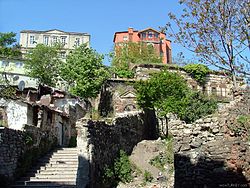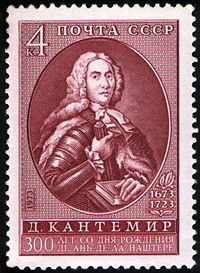- Dimitrie Cantemir
-
Dimitrie Cantemir 
Portrait of Dimitrie Cantemir (engraving)Born October 26, 1673
SilişteniDied August 21, 1723 Nationality Moldavia, Romania Dimitrie Cantemir (Romanian: [diˈmitri.e kanteˈmir]; 1673 – 1723) was twice Prince of Moldavia (in March–April 1693 and in 1710–1711). He was also a prolific man of letters – philosopher, historian, composer, musicologist, linguist, ethnographer, and geographer.
His name is spelled Dimitrie Cantemir in Romanian, Dmitriy Konstantinovich Kantemir (Дмитрий Константинович Кантемир) in Russian, Dimitri Kantemiroğlu in Turkish, Dymitr Kantemir in Polish, Dimitrios Kantemiris (Δημήτριος Καντεμίρης) in Greek and Demetre Cantemir in several other languages.
Contents
Life and family
Born in Silişteni (renamed Dimitrie Cantemir and now located in Vaslui County, Romania), Dimitrie was the son of Moldavian Voivode Constantin Cantemir (and brother to Antioh Cantemir, himself Prince), of the low-ranking boyar Cantemireşti family. His mother, Ana Bantăş, was a learned woman of noble origins. (Cantemir never forgot his paternal ancestry, but while in Constantinople because of his name similarity locals inspired him to claim descent from Khan Temir, an early 17th century khan of the Budjak Tatars – see Moldavian Magnate Wars' on some occasions'.)
His education began at home, where he learned Greek and Latin and acquired a profound knowledge of the classics. Between 1687 and 1710 he lived in forced exile in Istanbul, where he learned Turkish and studied the history of the Ottoman Empire at the Patriarchate's Greek Academy, where he also composed music.
In 1693, he succeeded his father as Prince of Moldavia – in name only, as the Ottomans appointed Constantin Duca, favoured by Wallachian Prince and, despite many shared goals, forever rival of the Cantemirs Constantin Brâncoveanu; his bid for the throne was successful only in 1710, after two rules by his brother (whom he represented as envoy in the Ottoman capital). He had ruled only three weeks[1] when he joined Peter the Great in his campaign against the Ottoman Empire (see Russo-Turkish War, 1710–1711) and placed Moldavia under Russian suzerainty, after a secret agreement signed in Lutsk.
Defeated by the Turks in the battle of Stănileşti (July 18–July 22, 1711), Cantemir sought refuge in Russia, where he and his family finally settled (he was accompanied by a sizeable boyar retinue, including the chronicler Ion Neculce). There, he was awarded the title of Knyaz (Prince) of the Russian Empire by Peter the Great and received the title of Reichsfürst (Prince) of the Holy Roman Empire from Charles VI. He died at his Dmitrovka estate near Oryol in 1723 (on the very day he was awarded the Roman-German princely title). In 1935, his remains were carried to Iaşi.
 Posthumous portrait of Anastasia Ivanovna, Countess of Hesse-Homburg, Princess Trubetskaya by Alexander Roslin (1757)
Posthumous portrait of Anastasia Ivanovna, Countess of Hesse-Homburg, Princess Trubetskaya by Alexander Roslin (1757)
Melbourne, National Gallery of VictoriaHe was married twice: in 1699, to Kassandra Cantacuzene (1682–1713), member of the Cantacuzino family (the daughter of Prince Şerban Cantacuzino), and in 1717 to Anastasia Trubetskaya (1700–1755; from the Trubetskoy house).
 Portrait of Princess Ekaterina Dmitrievna Golitsyna by Louis-Michel van Loo (1759)
Portrait of Princess Ekaterina Dmitrievna Golitsyna by Louis-Michel van Loo (1759)
Moscow, Pushkin Museum of Fine ArtsCantemir's children were rather prominent in Russian history. His elder daughter Maria Cantemir (1700–1754) attracted the attention of Peter the Great who allegedly planned to divorce his wife Catherine and marry her. Upon Catherine's ascension to the throne, she was forced to enter a convent. His son Antioh Cantemir (Antiokh Dmitrievich in Russian) (1708–1744) was also the Russian ambassador to London and Paris, a prominent satirical poet, and Voltaire's friend. Another son, Constantin (Konstantin Dmitrievich; 1703–1747), was implicated in the Galitzine conspiracy against Empress Anne and exiled to Siberia. Finally, Dimitrie's younger daughter Smaragda (1720–1761), the wife of Prince Dmitriy Mikhailovich Galitzine, was a friend of Empress Elizabeth and one of the great beauties of her time.
Works
History, geography, philosophy and linguistics
In 1714 Cantemir became a member of the Royal Academy of Berlin. Between 1711 and 1719 he wrote his most important creations. Cantemir was known as one of the greatest linguists of his time, speaking and writing eleven languages, and being well versed in Oriental scholarship. His oeuvre is voluminous, diverse, and original; although some of his scientific writings contain unconfirmed theories and inaccuracies, his expertise, sagacity, and groundbreaking researches are widely acknowledged.
The best known is his History of the Growth and Decay of the Ottoman Empire. This volume circulated throughout Europe in manuscript for a number of years. It was finally printed in 1734 in London, and later it was translated and printed in Germany and France. It remained the seminal work on the Ottoman Empire up to the middle of the 19th century – notably, it was used as reference by Edward Gibbon for his The History of the Decline and Fall of the Roman Empire. Afterwards, the work was largely contested, for some of its sources were doubtful.
In 1714, at the request of the Royal Academy in Berlin, Cantemir wrote the first geographical, ethnographical and economic description of Moldavia, Descriptio Moldaviae. As many of his books it circulated first in manuscript and was only later published in Germany (first in 1769 in a geographical magazine, and then in 1771 the first edition as a book). Around the same time he prepared a manuscript map of Moldavia, the first real map of the country. It contained a lot of geographical detail as well as administrative information. Printed in 1737 in the Netherlands, it has been used by all cartographers of the time as an inspiration for their own maps of Moldavia.
Other writings:
- A history and notation of Ottoman court music.
- The first critical history of Romania as a whole, under the name of Hronicul vechimii a romano-moldo-valahilor – approx. "Chronicle of the durability of Romans-Moldavians-Wallachians" (1719–1722).
- The first Romanian language novel, the cryptic Historia Hieroglyphica (1705), to which he furnished a key, and in which the principal persons are represented by mythological beasts; it is the history of the two Wallachian ruling houses of Brâncoveanu and Cantacuzino.
- A philosophical treatise, written in Romanian and also in Greek, translated into Arabic, under the title Divanul sau Gâlceava Înţeleptului cu lumea sau Giudeţul sufletului cu trupul (Iaşi, 1698) – Le divan ou la dispute du sage avec le monde ou le jugement de l'âme avec le corps in French ("The Divan or The Wise Man's Parley with the World or The Judgement of the Soul with the Body").
- An unfinished second treatise (Istanbul, 1700), Sacrosantae scientiae indepingibilis imagio or Imaginea ştiinţei sacre, care nu se poate zugrăvi ("The Image of the Sacred, Undepictable Science").
- An introduction to Islam written for Europeans.
- A biography of Jan Baptist van Helmont (Cantemir, 1709).[2] This work is cited by Debus (2002),[3] on pages 212-213.
Due to his many esteemed works he won great renown at the high courts of Europe. His name is among those who were considered to be the brightest minds of the world on a plaque at the Library of Sainte-Genevieve in Paris, next to those of Leibnitz, Newton, Piron, and other great thinkers.
Musicology
Some of Cantemir's compositions are part of the regular repertory of Turkish music ensembles. In 1999, the Bezmara ensemble have recorded an album, Yitik Sesin Peşinde ("In Search of the Lost Sound") from the Cantemir transcriptions using period instruments.[4]
In 2000, Golden Horn Records released a CD exploring Cantemir's compositions, European composers of Cantemir's era, and folk music of Moldavia. Featuring solo improvisations on kemençe (Turkish bowed fiddle) and tanbur (Turkish long-necked plucked lute) by famed master Íhsan Özgen and early music ensemble Lux Musica directed by Linda Burman-Hall, the project fulfills an ambitious endeavor by Özgen and Burman-Hall to meld early European music styles and instruments with today's Turkish art music styles and instruments, with Cantemir as their touchstone.[5]
In 2009, Alia Vox published a CD and booklet of music performed by the Hespèrion XXI ensemble and invited musicians under the baton of Jordi Savall. The recording and booklet both pertain to “The Book of the Science of Music” by Cantemir and the Sephardic and Armenian musical traditions. Seven of Cantemir's compositions are included in the recording along with other Turkish, Armenian and Sephardic music. [6]
He had around 40 compositions in the Ottoman music of which few are performed today, but his greatest service to the Ottoman music is the fact that he helped survival of 350 instrumental pieces by recording them in a certain notation (the ebced) script he developed in his work Edvar which he presented to Sultan Ahmed III.
The most recent publication of his abovementioned work, reprint along with complete transcription and explanations, is: Kantemiroğlu, Kitâbu 'İlmi'l-Mûsiki alâ Vechi'l-Hurûfât, Mûsikiyi Harflerle Tesbit ve İcrâ İlminin Kitabı, Yalçın Tura, Yapı Kredi Yayınları, Istanbul 2001, ISBN 975-08-0167-9. Romanian historian and musicologist Eugenia Popescu-Judetz has numerous works on Cantemir, the most recent of which being a monograph (in English, also translated into Turkish): Prince Dimitrie Cantemir, Theorist and Composer of Turkish Music, Eugenia Popescu-Judetz, Pan Yayıncılık, Istanbul 1999, ISBN 975-7652-82-2.
References
- Sources consulted
 This article incorporates text from a publication now in the public domain: Chisholm, Hugh, ed (1911). Encyclopædia Britannica (11th ed.). Cambridge University Press.
This article incorporates text from a publication now in the public domain: Chisholm, Hugh, ed (1911). Encyclopædia Britannica (11th ed.). Cambridge University Press.
- Endnotes
- ^ Stefan Lemny. Les Cantemirs: L'aventure Europeene d'une Famille Princiere au XVIIIe Siecle. (Editions Complexes, Paris: 2009), p. 51.
- ^ Catemir, Dimitri (Demetrius) (1709); Ioannis Baptistae Van Helmont physices universalis doctrine et christianae fidei congrua et necessaria philosophia. Wallachia.
- ^ Debus, Allen G. (2002); The Chemical Philosophy: Paracelsian science and medicine in the sixteenth and seventeenth centuries. Courier Dover Publications, 609 pp.
- ^ (1999) Album notes for In Search of the Lost Sound by Bezmara [album booklet]. Istanbul: Kalan Müzik (ISBN 8-691834-003576).
- ^ (2000) Album notes for Cantemir: Music in Istanbul and Ottoman Europe around 1700 by Lux Musica [album booklet]. Santa Cruz, CA: Golden Horn.
- ^ (2009) Album notes for Istanbul - Dimitrie Cantemir by Hespèrion XXI [album booklet]. Bellaterra, Spain: Alia Vox.
External links
- (Romanian) Biography
- Genealogy of the Cantemir family
- Music of Cantemir (Golden Horn Records)
- Music CD with booklet: Istanbul - Dimitrie Cantemir - Jordi Savall (Alia Vox)
- Istanbul. Dimitrie Cantemir - "Le livre de la Science de la Musique" - "The Book of the Science of Music" - Hespèrion XXI - dir. Jordi Savall
- (Latin) Descriptio Moldaviae at Latin Wikisource
- (Romanian) Istoria ieroglifică at Romanian Wikisource
Preceded by
Constantin CantemirPrince/Voivode of Moldavia
1693Succeeded by
Constantin DucaPreceded by
Nicolae MavrocordatPrince/Voivode of Moldavia
1710–1711Succeeded by
Caimacam Lupu CostachiFigures in the Age of Enlightenment by country or region Notable figures America (English) America (Latin) England Edward Gibbon · Thomas Hobbes · Samuel Johnson · Edmund Burke (Irish born) · John Locke · Isaac Newton · Robert WalpoleFrance Germany Greece Hungary Italy Low Countries Poland-Lithuania Portugal Romanian States Russia Scandinavia Scotland Serbia Spain Ukraine Related topics Categories:- 1673 births
- 1723 deaths
- People from Vaslui County
- 18th-century Latin-language writers
- Cantemireşti family
- Enlightenment philosophers
- German nobility
- Imperial Russian politicians
- Medieval and Early Modern Romanian writers
- Members of the Prussian Academy of Sciences
- Ottoman composers
- Romanian composers
- Romanian historians
- Romanian linguists
- Romanian orientalists
- Romanian philosophers
- Rulers of Moldavia
- Turkologists
- 17th-century Romanian people
- 18th-century Romanian people
Wikimedia Foundation. 2010.



